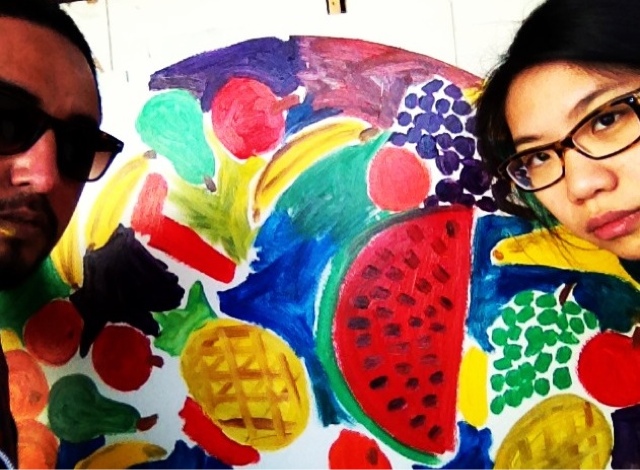Wednesday, June 26, 2013
Tuesday, June 25, 2013
Kiss my ass!
Friday, June 21, 2013
Wednesday, June 19, 2013
Howard Arkley & Juan Davila, Blue chip instant decorator, 1991
X detail X detai | Since the late eighties Juan Davila and Howard Arkley have been engaged in an extensive collaborative partnership that has been taking place almost imperceptibly in the gap between their individual oeuvres. In 1991, at Tolarno Galleries in South Yarra, the evidence of this project surfaced for the first time in a back room installation titled Blue Chip Instant Decorator. Arkley and Davila continued to modify this work as it was exhibited again briefly in Melbourne and Sydney before being put into storage. They still exchange ideas with the intention of further collaborations but Blue Chip Instant Decorator remains the only manifestation of a remarkable partnership between two of Australia's most prominent painters. The significance of Blue Chip Instant Decorator is immediately evident in the way that Arkley and Davila have reinvented the concept of "collaboration". Rather than evoking the cosy pluralism of group projects from the seventies, or the dry hybridity of multiple-author works from the eighties, their exchange has been full of surprises and false starts. It is as if they were continually negotiating temporal personae in a virtual environment or hyper-textual novel. Their collaboration has, in effect, functioned like the stage set for a comedy of misadventure.
|
X detail | Despite the obvious formal differences between the work of Arkley and Davila, they share a certain ethic of open-ended experimentation. In Arkley's work this is apparent in the fuzzy contours that zig-zag, glide and spiral across the canvas, spreading out a zone of indetermination between the flat planes of colour and the floating airbrushed line. Davila, on the other hand, improvises to the disjunctive rhythm of collage and quotation, assembling a network of experimental and temporal connections. The success of their collaboration undoubtedly owes something to how they offer each other different ways of realising this ethic of experimentation. Traversing one another like the woof and warp of a garish new fabric, they recreate themselves in each other's conceptual gaps. As Davila explains, it is a battle between two pictorial systems: "Howard does not touch the canvas whereas I paint in a dirty tactile way. So the question is how to position two pictorial systems once you've set up a mutual image. Each hand proceeds in its own way." For both artists, the incentive to collaborate was the possibility of finding a counterpoint that would give something new to their work and take it in a different direction. This is particularly obvious in Davila's work, where decorative screens and ornament have become an important feature of his solo shows since beginning the collaboration. "Juan had used patterning in the past," Arkley reflects ironically, "but this project really kicked it along. I set it up thinking that I would get a lot out of it, but it turned out differently." |
X detail | The unpredictable nature of the exchange becomes apparent when they are asked to explain the origins of the project, because in effect there are no origins. Everything happened in-between.
|
X detail | Blue Chip Instant Decorator occupies a pivotal place in the oeuvres of these two artists, but its significance also extends to the broader currents in contemporary Australian art. Arkley and Davila showed work together for the first time in the renown "Popism" exhibition of 1981, curated by Paul Taylor at the National Gallery of Victoria. This event harnessed the concerns of a new generation of Australian artists and indexed a conceptual shift into problems framed by Postmodernism and Post-colonialism. Like most of the artists in this exhibition, Arkley and Davila take up provincial perspectives on popular art and culture, testifying to the displacement and complication of identity at the ends of the world. But fifteen years later these issues have become institutional cliches of Australian art, issues which are complicit with our government's "Pacific rim" policies on trade, arts and tourism. What once seemed politically subversive is now a necessary criteria for inclusion in most survey show of Australian art. The theme of interior decoration in Blue Chip Instant Decoratoris quite literally the vehicle for parodying the commercial ends to which Postmodern and Post-colonial debates have been turned over the past decade. The tensions between Arkley's cool stylisation of suburban dreamscapes, and Davila's purulent pop imagery from non-Western contexts, run like fault lines across the parochial domestic scenes in the paintings. Blue Chip Instant Decorator provides a timely critique of the mix and match exotica that inadvertently persists in Post-colonial aesthetics. As Juan explains:
Blue Chip Instant Decorator is more than a curious art object pieced together in Arkley and Davila's spare time. It poses important problems for the two artists and for Australian art; problems that could perhaps only be developed in the margins of their careers, in an interval of trust and friendship. As such it is a singular event, a remarkable coordinate in the matrix of contemporary art. Stephen O'Connell (Excerpt from a forthcoming Tolarno Galleries publication) |


















































